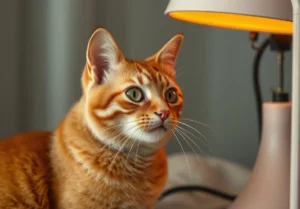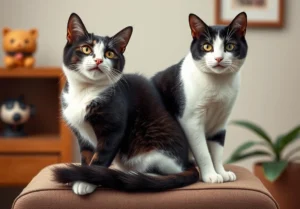Cats have a unique talent for positioning themselves right where you were just sitting. It’s as if they possess some sort of sixth sense that tells them your favorite spot has just been vacated. One moment you’re enjoying a cozy seat, and the next, you’re sharing it with a furry overlord.
Cats are naturally drawn to warmth, comfort, and familiarity, which is why they often claim your spot. It’s not just about being cozy; it’s also a way for them to mark their territory and seek attention from you.
What drives a cat’s desire for warmth
Cats are natural heat seekers. Their cozy little bodies thrive on warmth, and they’ll go to great lengths to find it. Have you ever noticed how your feline friend gravitates toward sunny spots or warm blankets? This instinct isn’t just about comfort but also a survival mechanism.
Cats have a higher body temperature compared to humans, typically ranging from 101 to 102.5 degrees Fahrenheit. In cooler environments, staying warm helps them conserve energy and maintain their health. So, when your cat steals your spot, they’re not being mischievous; they’re simply looking for the best warmth available.
Interestingly, research has shown that cats’ preference for warm surfaces can also be tied to their sense of security. A warm spot often feels safe; it mimics the cozy confines of a den. By claiming your spot, they’re not only enjoying the warmth but also marking their territory. This instinct plays into their ancestral behavior as both hunters and prey, where being warm and secure contributes significantly to their survival.
Is it about territory?
Cats are territorial creatures. They have a strong instinct to mark their space, and surprisingly, that includes claiming their human’s favorite chair or blanket. When your cat curls up on your recently vacated spot, they are sending a clear message: “This is mine now.”
This behavior ties into their instinctual need to assert dominance over their environment. They may rub their scent glands against your belongings, leaving a unique mark that says they’ve claimed it. It’s a comforting behavior that provides a sense of safety and ownership in their surroundings.
Here’s an interesting breakdown of how your cat’s territorial behavior manifests:
- Scent Marking: Cats have scent glands in their cheeks, paws, and forehead. When they rub against your belongings, they’re claiming it as theirs.
- Vocalization: Some cats might even vocalize to express discontent when their space is not respected, adding extra emphasis to their claim.
- Positioning: If you often notice your cat sitting higher up than everyone else, it’s their way of asserting their dominance over the environment.
- Resource Guarding: Not just spots—cats can be guarded about toys, food, and even your attention, as they see these as part of their territory.
An excellent resource on feline behavior can be found at the ASPCA’s website, where they offer insights into how territoriality impacts cat behavior: ASPCA Feline Behavior.
Understanding this natural instinct can help you navigate your cat’s quirky actions. You might want to offer them their own cozy spot nearby—that way, you both can enjoy the warmth and a bit of peace!
What role does smell play in their choices?
Cats have an incredible sense of smell, which is crucial in guiding their behavior and preferences. When you’ve been lounging in your cozy spot, it quickly absorbs your unique scent. This personal aroma is more than just a comfortable reminder for your cat; it signals safety and familiarity, making it an enticing destination for them.
Cats have scent glands all over their bodies, especially around their cheeks and paws, which they use to mark their territory. When they choose your spot, they’re often engaging in territorial behavior. Your scent says, “This is mine,” but to them, it’s a signal that they’ve found a safe, warm place bathed in a loved one’s comforting scent.
Additionally, consider that your spot might have appealing qualities, too, like warmth from the sun or the coziness of a favorite blanket. Here are some key points to consider regarding smell’s influence:
- Personal Aroma: Your scent means safety and comfort.
- Territorial Instinct: Cats mark their territory, and your spot is part of it.
- Environmental Factors: Heat and texture matter, heightening the allure.
Ultimately, those moments when your cat claims your space speak volumes about their need for security and connection, powered by their incredible olfactory senses.
Cats are social creatures, often forming tight bonds with their human companions. Unlike the stereotype of the aloof feline, many cats thrive on interaction. They often seek out closeness, especially in areas where they can feel connected to you, even when you’re not actively engaging.
When your cat steals your spot, it’s not just about comfort—it’s also about companionship. They want to be near you and have a sense of shared space. This behavior stems from their instinctual need to bond with their humans. Marking your spot enables them to feel closer to you, even if you’re out of sight.
Moreover, cats are sensitive to your mood and behaviors. If you’ve had a long day or you’re feeling under the weather, they might opt to snuggle into your spot as a comforting gesture. Here’s how their social nature impacts this behavior:
- Seeking Comfort: Cats feel safe in your presence, even if you’re not there.
- Attention and Bonding: They want to stay near their favorite human.
- Empathy: They often mirror your emotions, grabbing your spot when they sense your need for comfort.
Helping your cat feel secure and attentive can enrich your bond. Consider designating another comfy spot nearby, or even considering a little cat bed near your favorite chair, giving them a cozy alternative while still allowing for that close connection.
Do the insights from body language matter?
Cats are masters of nonverbal communication, and their body language plays a crucial role in their interactions, even when they’re making a move for your spot. When a cat approaches your chair or lap, keep an eye out for their posture. A relaxed cat may approach with a slight crouch but will generally look comfortable and confident. This indicates they’re claiming your space as a personal safe haven, rather than being aggressive or territorial.
Their tail position is another telltale sign. If it’s held upright with a slight curve at the tip, that’s a friendly vibe, suggesting they’re comfortable and happy to settle in. Conversely, if the tail is puffed or low, they might be feeling defensive or unsure about lounging there.
Another behavior to note is the kneading action. When they pounce down with their front paws, it’s a comforting behavior rooted in kittenhood, which means they feel secure and often want to be close to you. Occasional head-butting or rubbing against you can also signal a desire to share affection and territory, reinforcing the bond you share.
Understanding this language can help you appreciate why they feel drawn to your spot—it’s not just comfort; it’s about connection, safety, and love.
Why do cats prefer your lap?
A warm lap isn’t just a cozy resting place for a cat; it symbolizes a connection. Cats gravitate toward your lap because it’s a spot that radiates heat and comfort, which are appealing for their survival instincts. Your body heat provides a cozy environment, which is particularly attractive when they’re looking to conserve energy or get some Z’s.
This behavior goes deeper; it’s a sign of trust and affection. When a cat chooses your lap, they’re signaling that they feel safe and secure with you. In the wild, cats often seek shelter to protect themselves from predators, so curling up on your lap is a form of seeking safety.
Beyond just warmth, the lap becomes a base for nurturing social bonds. A cat cuddling with you releases a blend of hormones that deepen the trust and bond between you both. They’re not just looking for comfort, but are also reinforcing the emotional connection that makes you both feel good.
Key reasons why cats love your lap:
- Comfort: Your warmth provides a cozy spot.
- Safety: They feel secure and protected.
- Bonding: Physical closeness deepens emotional connections.
- Territory: Your lap becomes a favorite space they claim.
If you really want to encourage your furry friend to settle comfortably, consider investing in a soft blanket for your lap. It can make a welcoming spot that feels special for them, while reducing the risk of fur everywhere!
For more insights on cat behavior, check out the Cat Welfare Association for resources that can help you understand your feline better.
Do changes in routine affect a cat’s behavior?
Cats are creatures of habit, and any shift in your daily routine can lead to noticeable changes in their behavior, especially when it comes to choosing their cozy spots. If you suddenly start working from home instead of heading to the office, your feline buddy might feel the need to claim the space you once occupied. Cats often seek out areas where they can feel safe and secure, and your absence in a specific spot can prompt them to take it over, feeling it’s now available.
Moreover, during periods of stress or upheaval, like moving to a new house or introducing a new pet, a cat may gravitate toward previously occupied areas that bring them comfort. They thrive on predictability, so any routine change might prompt them to explore and assert their presence in spots they see as hubs of activity.
Insightful Tip: Observing your cat’s spot preferences during these changes can give you clues about their emotional state. Providing a dedicated resting area where they feel safe can help mitigate any stresses caused by routine shifts.
What unique quirks do different breeds have?
Each cat breed comes with its own distinct personality and preferences regarding resting spots. For instance, Siamese cats are known for being social butterflies. They often prefer to claim spots close to their humans, demanding attention and companionship. On the other hand, Maine Coons tend to enjoy larger, cozier spaces where they can stretch out comfortably and survey their surroundings.
Here’s a quick rundown of some breed-specific quirks regarding spot stealing:
- Bengal: Often seeks elevated spots to get a bird’s-eye view of their territory.
- Ragdoll: Loves to lounge on laps and be near their owners for maximum cuddle time.
- Scottish Fold: Enjoys snug, enclosed spaces where they can curl up and snooze peacefully.
Understanding these quirks can help you tailor your home environment to meet your cat’s needs, making everyone happier.
Extra Insight: Consider giving your cat multi-level perches or cozy hiding nooks to satisfy their spot-stealing habits. These additions can become their favorite spots, allowing them to fulfill their natural instincts while leaving your chosen seat free for you!
For more information on interpreting your cat’s behaviors, the American Association of Feline Practitioners has valuable resources worth checking out: AAFP
How can you reclaim your space?
Cats have an uncanny knack for appropriating your favorite spot, but that doesn’t mean you have to surrender your territory. Here are some practical strategies for sharing your space while keeping the peace with your feline friend:
Create Cozy Spots : Invest in a few cushy cat beds or blankets in areas that are frequently claimed by your cat. This gives them an appealing option that might distract them from the warm seat you just vacated.
Elevate Their Views : Cats love to observe from heights. Providing a cat tree or shelves near windows can not only keep them entertained but may also deter them from stealing your lap when they have their own prime perch.
Give It Time : Oftentimes, cats may just be looking for warmth or comfort. By ensuring they have access to their own cozy spaces, you can reclaim your spot without constant battle.
Enrichment Activities : Engage your cat with interactive toys or puzzles. A content cat is less likely to invade your territory if they’re busy enjoying their own activities.
Set Boundaries : Identify specific furniture where they aren’t allowed. Use methods like double-sided tape or citrus scents to discourage them from settling down in your spot.
By establishing these practical strategies, you can foster a more harmonious living situation while still enjoying your favorite places.
Are there any amusing anecdotes?
Cats have a flair for drama and mischief. Imagine settling into your favorite chair with a warm beverage, only to have your kitty saunter over and plop down right where you were about to sit. It’s like they have a sixth sense for knowing exactly when you’re ready to take a load off!
One friend of mine shared a hilarious tale of her cat, Mr. Whiskers, who made it a habit to claim her work-from-home setup. Every single time she got ready to type, Mr. Whiskers would jump right onto her keyboard, splaying out as if it were a royal throne. It got to the point where she had to set up a second workstation on a high shelf just to keep him from participating in every Zoom call!
Another story features a cat named Luna who once strategically stole her owner’s blanket right as he settled in for the night. She didn’t just claim the spot—she would curl up to look like the perfect croissant, leaving her owner with only the edge of the bed. Talk about a power play!
Cats have all sorts of antics that highlight their adorable (and sometimes exasperating) personalities, proving they won’t let something as silly as human comfort stand in their way!
What to do when your cat won’t budge
Cats have a knack for making themselves comfortable in your favorite spot, leaving you with that lingering sense of frustration and adoration all at once. It’s part of their charm, though it can be a bit trying when you’ve finally settled in for a relaxing evening. Here are some practical tips to manage this endearing behavior.
Start by creating alternative cozy zones for your kitty. Place soft blankets or pet beds in various areas of your home. You might find that offering a designated cozy spot will entice them away from where you want to sit.
Redirect their attention with interactive toys or snacks. If your cat is sprawled across your chair, try tossing a toy nearby or rustling a treat bag. The distraction can encourage them to vacate your spot while still providing engagement they crave.
Another trick is to establish cat-friendly spaces. Cats appreciate high spots, so consider investing in a cat tree. They love to perch up high, which might divert their interest away from your cherished spot.
You may also want to embrace it! If your cat insists on claiming your lap, accept it as a sign of affection. Snuggling with your cat can be quite therapeutic, and it gives you quality time together.
If all else fails, you can gently move them. A firm yet gentle lift will usually get the message across. Just be prepared for a little plotting; they might return as soon as you stand up!
Extra Tip: Consider trialing pheromone diffusers or sprays that calm your cat and might reduce their urge to claim your space, especially during stressful situations or changes in routine. Check out resources like the ASPCA for more insights into cat behavior and comfort solutions.
Alex, a passionate animal lover, has experience in training and understanding animal behavior. As a proud pet parent to two dogs and three cats, he founded AnimalReport.net to share insights from animal experts and expand his knowledge of the animal kingdom.




